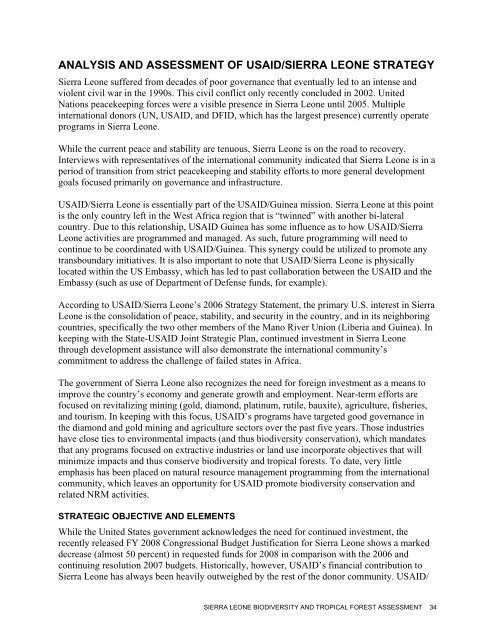118/119 Biodiversity and Tropical Forest Assessment for Sierra Leone
118/119 Biodiversity and Tropical Forest Assessment for Sierra Leone
118/119 Biodiversity and Tropical Forest Assessment for Sierra Leone
You also want an ePaper? Increase the reach of your titles
YUMPU automatically turns print PDFs into web optimized ePapers that Google loves.
ANALYSIS AND ASSESSMENT OF USAID/SIERRA LEONE STRATEGY<br />
<strong>Sierra</strong> <strong>Leone</strong> suffered from decades of poor governance that eventually led to an intense <strong>and</strong><br />
violent civil war in the 1990s. This civil conflict only recently concluded in 2002. United<br />
Nations peacekeeping <strong>for</strong>ces were a visible presence in <strong>Sierra</strong> <strong>Leone</strong> until 2005. Multiple<br />
international donors (UN, USAID, <strong>and</strong> DFID, which has the largest presence) currently operate<br />
programs in <strong>Sierra</strong> <strong>Leone</strong>.<br />
While the current peace <strong>and</strong> stability are tenuous, <strong>Sierra</strong> <strong>Leone</strong> is on the road to recovery.<br />
Interviews with representatives of the international community indicated that <strong>Sierra</strong> <strong>Leone</strong> is in a<br />
period of transition from strict peacekeeping <strong>and</strong> stability ef<strong>for</strong>ts to more general development<br />
goals focused primarily on governance <strong>and</strong> infrastructure.<br />
USAID/<strong>Sierra</strong> <strong>Leone</strong> is essentially part of the USAID/Guinea mission. <strong>Sierra</strong> <strong>Leone</strong> at this point<br />
is the only country left in the West Africa region that is “twinned” with another bi-lateral<br />
country. Due to this relationship, USAID Guinea has some influence as to how USAID/<strong>Sierra</strong><br />
<strong>Leone</strong> activities are programmed <strong>and</strong> managed. As such, future programming will need to<br />
continue to be coordinated with USAID/Guinea. This synergy could be utilized to promote any<br />
transboundary initiatives. It is also important to note that USAID/<strong>Sierra</strong> <strong>Leone</strong> is physically<br />
located within the US Embassy, which has led to past collaboration between the USAID <strong>and</strong> the<br />
Embassy (such as use of Department of Defense funds, <strong>for</strong> example).<br />
According to USAID/<strong>Sierra</strong> <strong>Leone</strong>’s 2006 Strategy Statement, the primary U.S. interest in <strong>Sierra</strong><br />
<strong>Leone</strong> is the consolidation of peace, stability, <strong>and</strong> security in the country, <strong>and</strong> in its neighboring<br />
countries, specifically the two other members of the Mano River Union (Liberia <strong>and</strong> Guinea). In<br />
keeping with the State-USAID Joint Strategic Plan, continued investment in <strong>Sierra</strong> <strong>Leone</strong><br />
through development assistance will also demonstrate the international community’s<br />
commitment to address the challenge of failed states in Africa.<br />
The government of <strong>Sierra</strong> <strong>Leone</strong> also recognizes the need <strong>for</strong> <strong>for</strong>eign investment as a means to<br />
improve the country’s economy <strong>and</strong> generate growth <strong>and</strong> employment. Near-term ef<strong>for</strong>ts are<br />
focused on revitalizing mining (gold, diamond, platinum, rutile, bauxite), agriculture, fisheries,<br />
<strong>and</strong> tourism. In keeping with this focus, USAID’s programs have targeted good governance in<br />
the diamond <strong>and</strong> gold mining <strong>and</strong> agriculture sectors over the past five years. Those industries<br />
have close ties to environmental impacts (<strong>and</strong> thus biodiversity conservation), which m<strong>and</strong>ates<br />
that any programs focused on extractive industries or l<strong>and</strong> use incorporate objectives that will<br />
minimize impacts <strong>and</strong> thus conserve biodiversity <strong>and</strong> tropical <strong>for</strong>ests. To date, very little<br />
emphasis has been placed on natural resource management programming from the international<br />
community, which leaves an opportunity <strong>for</strong> USAID promote biodiversity conservation <strong>and</strong><br />
related NRM activities.<br />
STRATEGIC OBJECTIVE AND ELEMENTS<br />
While the United States government acknowledges the need <strong>for</strong> continued investment, the<br />
recently released FY 2008 Congressional Budget Justification <strong>for</strong> <strong>Sierra</strong> <strong>Leone</strong> shows a marked<br />
decrease (almost 50 percent) in requested funds <strong>for</strong> 2008 in comparison with the 2006 <strong>and</strong><br />
continuing resolution 2007 budgets. Historically, however, USAID’s financial contribution to<br />
<strong>Sierra</strong> <strong>Leone</strong> has always been heavily outweighed by the rest of the donor community. USAID/<br />
SIERRA LEONE BIODIVERSITY AND TROPICAL FOREST ASSESSMENT 34

















